Connect with Us
602 Park Point Drive, Suite 225, Golden, CO 80401 – +1 303.495.2073
© 2025 Medical Affairs Professional Society (MAPS). All Rights Reserved Worldwide.
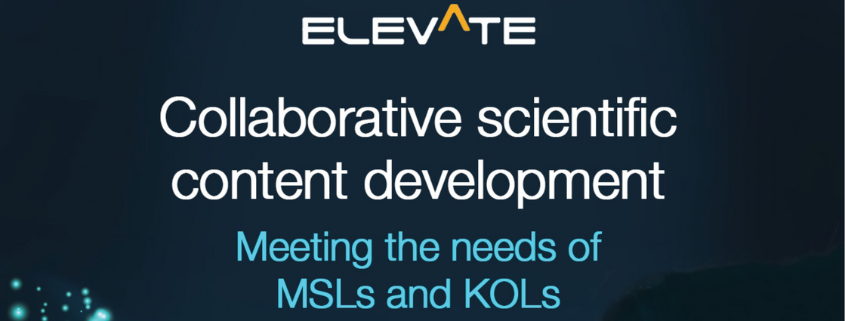
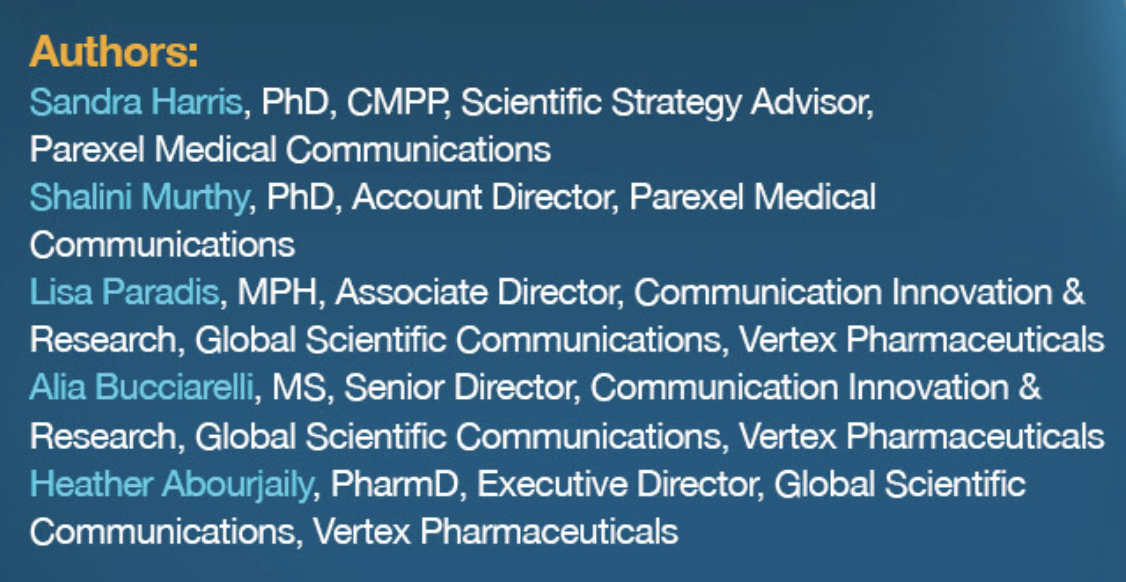
This article represents the views of the authors but does not represent the views of the authors’ organizations.
Abstract
Recent industry research on HCP communication preferences suggests that healthcare professionals (HCPs) have a slight preference for virtual platforms over in-person meetings, with many opting for the flexibility of both in-person and virtual settings. However, our existing Field Medical tools were designed primarily for face-to-face scientific exchange. Thus, we needed to optimize field materials for virtual engagement to enable medical science liaisons (MSLs) to convey information clearly, easily address questions, build trust, and deepen relationships in a virtual environment. Recognizing the importance of understanding the user experience, our approach relied on gathering feedback from the stakeholders involved: MSLs and HCPs. Insights from the MSLs were used to develop concepts for educational tools that were shared with key opinion leaders (KOLs). KOL feedback was then used to prioritize and refine our approach. We will highlight our discovery process and share key learnings from our MSL and KOL focus groups.
Introduction
Medical science liaisons (MSLs) are tasked with building relationships with clinicians and engaging in scientific exchange around the company’s pipeline and marketed products—this role is more challenging than ever. The Covid pandemic has affected where interactions between Field Medical teams and healthcare professionals (HCPs) take place and the way that information is shared. We sought to understand these challenges and address them by developing new tools designed to foster scientific exchange in the virtual world. Key to our approach was gathering insights from both the Field Medical team and the HCPs they serve.
The evolving landscape of HCP engagement
During the height of Covid, meetings between our Field Medical team and HCPs moved from primarily face-to-face to entirely virtual. In anticipation of having the option of face-to-face engagement again, we reviewed industry and company research on HCP communication preferences in mid-2021, which suggested that most HCPs want a mix of in-person and virtual options (Figure 1)1. Because our existing Field Medical tools were designed primarily for face-to-face scientific exchange, we needed to optimize them for virtual interactions.
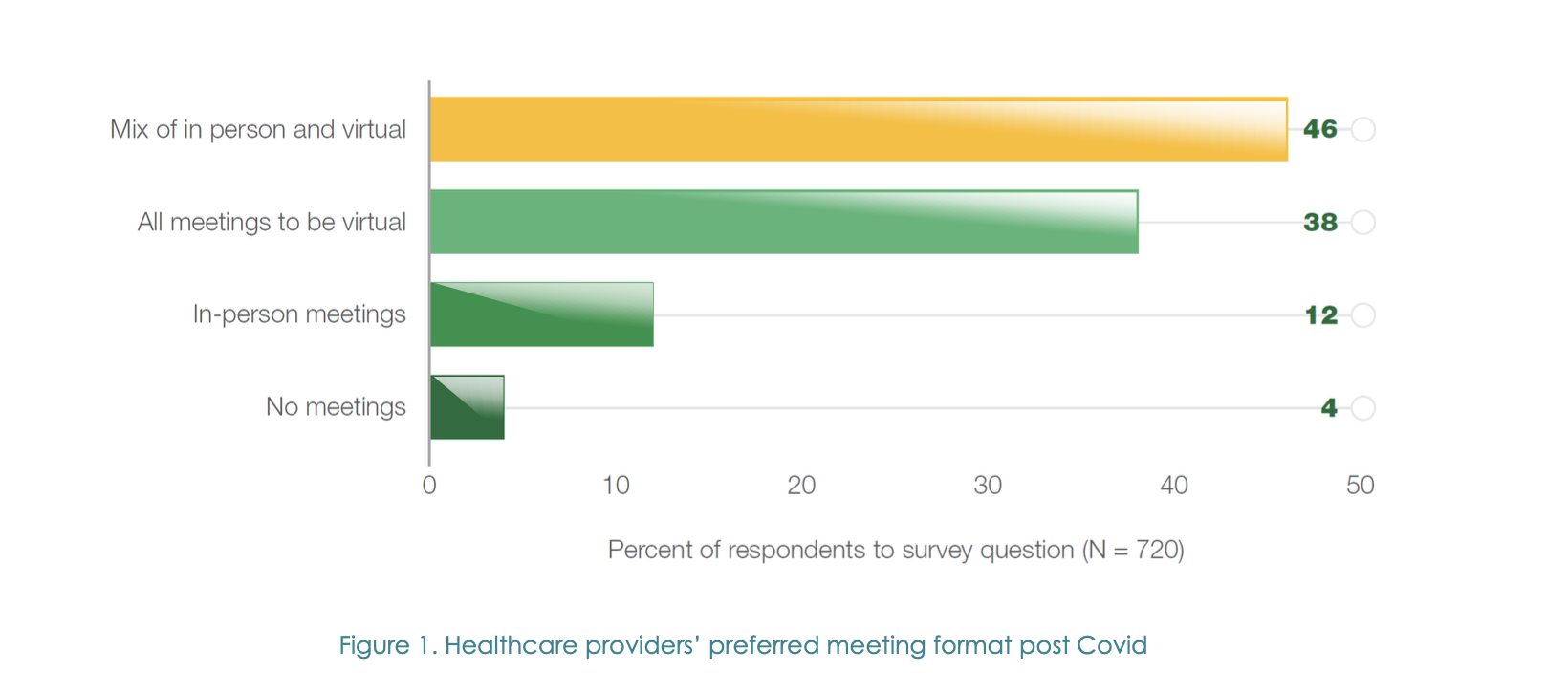
Our approach
Recognizing the importance of user experience, our approach relied on gathering feedback from the key stakeholders involved: MSLs and HCPs (Figure 2). The MSL insights we gathered were used to develop concepts for educational tools that were shared with key opinion leaders (KOLs). KOL feedback on each concept was then used to prioritize which tools to develop and to refine our approach.
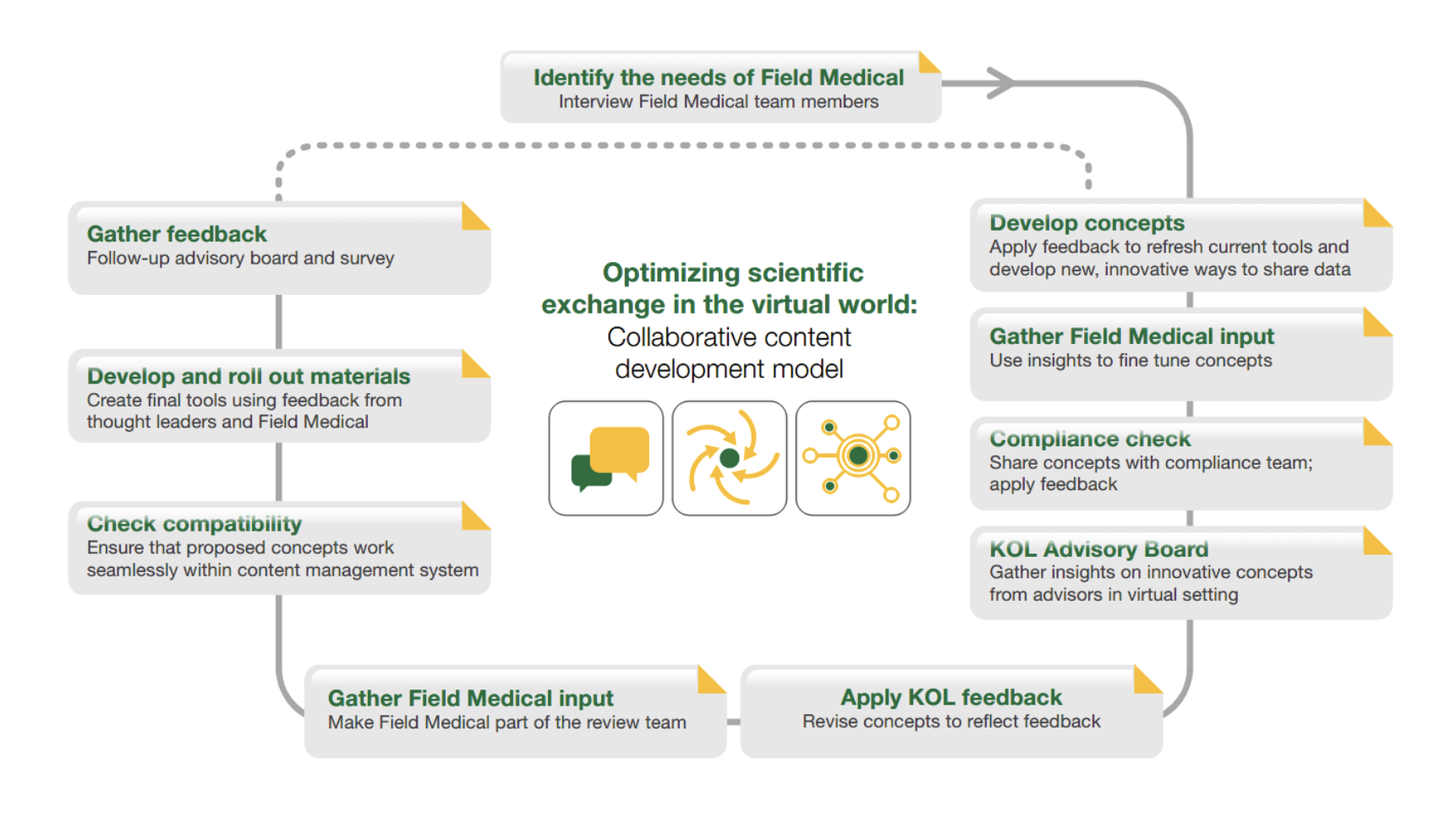
Identifying the needs of Field Medical
We conducted a series of one-to-one interviews with our Field Medical staff and medical directors to gain a deeper understanding of their day-to-day experiences and challenges. The feedback received is summarized in Figure 3. We learned that HCP interactions are typically shorter in the virtual environment, heightening the need for succinct and focused communication. MSLs need to be able to quickly navigate to the relevant information in response to a KOL’s question. Thus, MSLs value interactive tools that provide bite-sized summaries, allow easy navigation to more in-depth information, are visually compelling, and project well on a computer screen.
We also discussed the challenge inherent in creating tools that will be displayed from a content management platform. It is important to test the performance of new tools within required customer relationship management systems to ensure compatibility and ease of use.
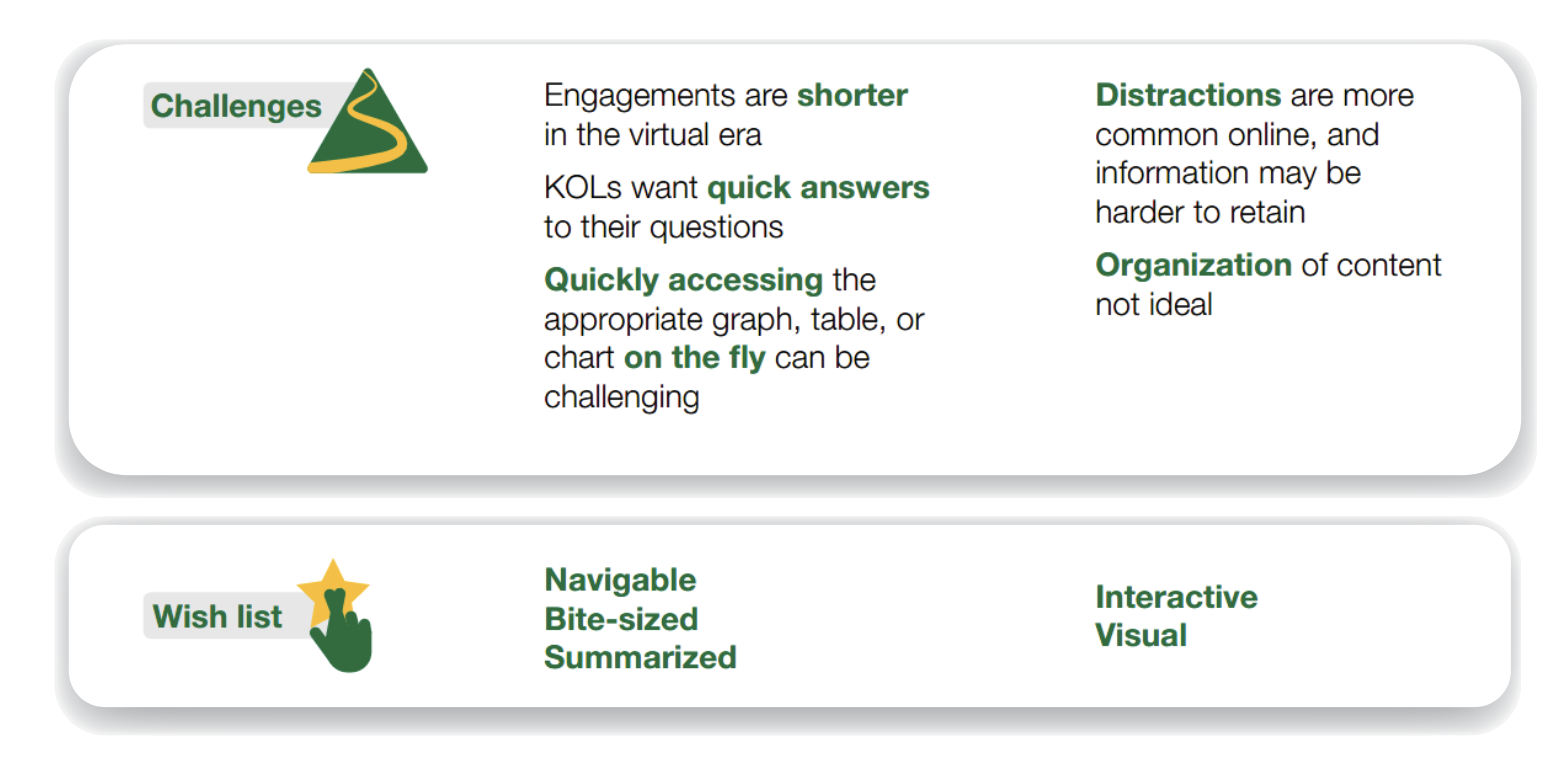
Gathering KOL Insights
We conducted three advisory boards using Zoom and an asynchronous insights management platform to understand KOLs’ communication preferences. We gathered feedback on concepts for potential new materials to assess if the level of detail and the graphical approaches used were appropriate and followed up to get input on final materials. KOL feedback informed the selection of concepts that moved into development.
Thought Leader feedback
Due to changes necessitated by Covid, many HCPs have become more comfortable with virtual meetings. We heard from KOLs who preferred in-person meetings for introductions or where a high level of interactivity is needed but valued the flexibility that virtual engagements offer. The KOLs indicated a preference for interactive discussion over didactic presentation. The ability to ask questions and have them answered by the MSL was key to a positive interaction.
After reviewing materials that could potentially be shared by MSLs in a virtual environment, the HCPs preferred:
Development of new scientific content formats
We developed several new types of scientific materials from the concepts shown to the MSLs and KOLs. Because a key topic of discussion between MSLs and KOLs is data presented at scientific congresses, improving how scientific posters are shown during engagements was a priority of this project. Sharing a poster PDF remotely over a small laptop or tablet screen can by dizzying, requiring an MSL to scroll across the poster to zoom in on specific data. An answer to this challenge has traditionally been to place the poster content into slides. We tested this concept as well as an “interactive” poster PDF that enables an MSL to click on and enlarge sections of the original poster while presenting to a KOL onscreen. The MSLs and thought leaders overwhelmingly preferred the interactive poster format over slides because it maintained the integrity of the original poster while enabling easy navigation—no more scrolling and zooming in and out!
Gathering feedback on final materials
As part of the process of continual improvement, we conducted a survey of MSLs three months after the new materials launched. We also conducted a follow-up advisory board with the same KOLs who had provided feedback on the concepts. By sharing video demonstrations of the new tools in action, we were able to show the advisors how we incorporated their feedback into the draft materials and got their ideas for further enhancements.
MSLs responded positively to questions around the use of an “interactive” poster and the feedback from advisors was unanimously positive with all advisors indicating that they would like MSLs to use the format when presenting new congress data to them (Figure 4). Several advisors indicated that they would use a copy of the poster for their personal use or to present to others if available.
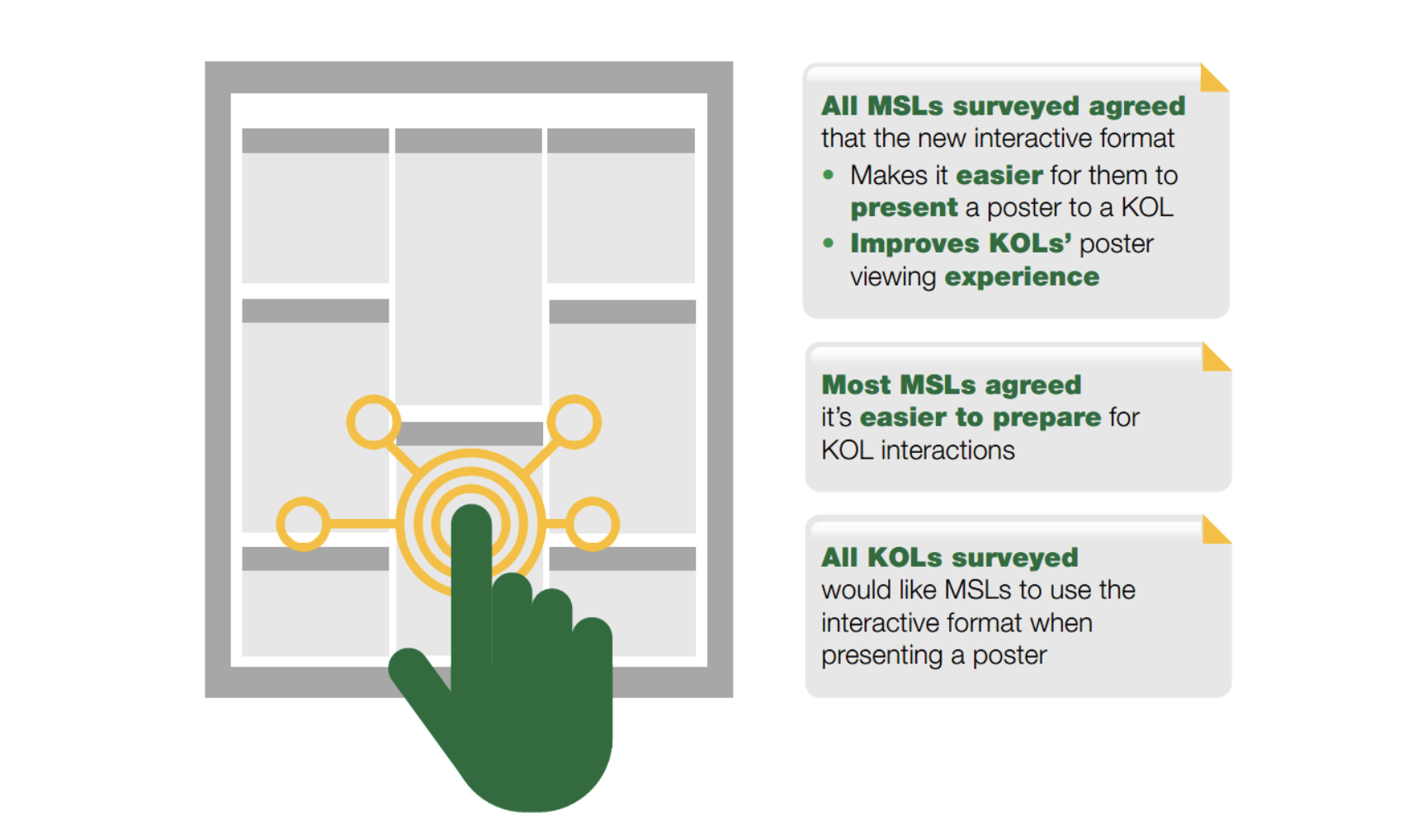
Making collaborative content development a reality
This pilot demonstrated that the time and resources spent getting user and audience feedback during content development are well worth the effort. We are now working on a collaborative content development model to build in critical, regular touchpoints for feedback on materials in development and ideas for new content.
Summary
The approach we’ve taken to develop new tools for scientific exchange is, in our experience, unique in Medical Affairs. Feedback from end users and audiences (Field Medical and HCPs) is not typically sought during the creation of content. We have found the process to be highly valuable. The co-creation process has enabled us to assess the needs of all stakeholders, build content designed to meet those needs, and create fit-for-purpose tools that provide value.
Reference
1. “The ‘new’ rules of engagement: How pharmaceutical companies can give HCPs the new and meaningful interactions they want.” Accenture Strategy and Consulting. Survey May-June 2021.
602 Park Point Drive, Suite 225, Golden, CO 80401 – +1 303.495.2073
© 2025 Medical Affairs Professional Society (MAPS). All Rights Reserved Worldwide.

 Optimize your Field Medical Team for the Omnichannel World
Optimize your Field Medical Team for the Omnichannel World